.png&w=1920&q=75)
Understanding LLaMA Index and Its Role in Large Language Models (LLM)
As large language models (LLMs) continue to grow in capability, one concept that has gained attention in the AI community is the LLaMA Index. While many are familiar with LLaMA (Large Language Model Meta AI), developed by Meta, the term LLaMA Index refers to a different, yet related, concept that helps manage and optimize large-scale language models.
In this article, we’ll dive into what LLaMA Index is, how it’s used in conjunction with LLMs, and why it’s important for making language models more efficient and usable.
reference link - llamaindex.ai
What Is LLaMA Index?
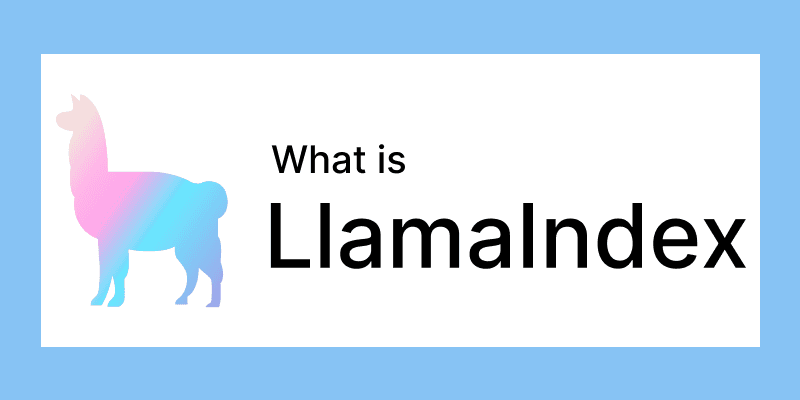
The LLaMA Index is a tool or technique designed to optimize the way large language models access, retrieve, and organize information. Essentially, it's an indexing system that helps large models like LLaMA (or other LLMs) work more efficiently when processing massive datasets or responding to complex queries.
Just like an index in a book helps readers quickly find information, a LLaMA Index helps a language model quickly locate the relevant pieces of data it needs to generate meaningful responses. This indexing is crucial because LLMs are often trained on huge amounts of data, and retrieving the right information from these vast data stores is a challenge.
Why Is LLaMA Index Important?
Large language models are powerful, but they can be slow and inefficient without an optimized way of retrieving information. Without a proper index, the model would have to search through the entire dataset every time it generates a response, which would take up time and computing resources.
Here’s why the LLaMA Index matters:
Improved Efficiency: By indexing data, the model can quickly pinpoint the relevant information, significantly speeding up response times and reducing the computational load.
Better Accuracy: When a model has a well-organized index, it can retrieve more accurate information, improving the quality of its responses. This is particularly important for tasks that require precise answers, such as question answering or summarization.
Scalability: As models grow larger and are trained on more data, the LLaMA Index becomes essential for managing this scale. It ensures that even if the dataset grows, the model can still retrieve information efficiently.
How Does the LLaMA Index Work?
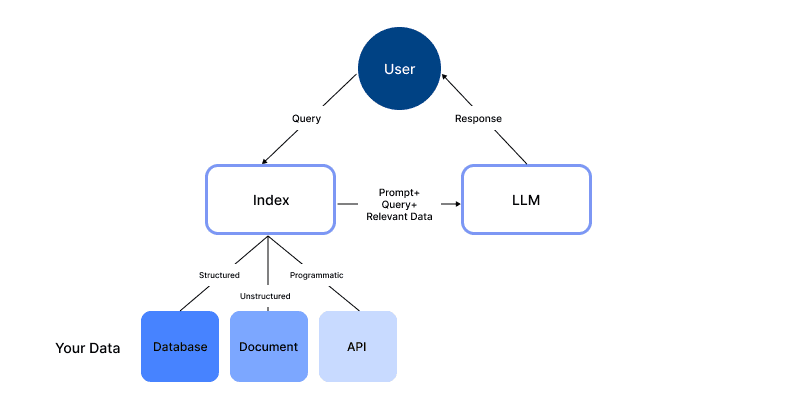
At a high level, the LLaMA Index works by creating a map or shortcut that helps the model locate specific pieces of information in its training data. Here’s a simplified breakdown of how it operates:
Data Collection: First, the model is trained on a large dataset, such as text from books, websites, or research papers. This data forms the foundation that the model uses to generate its responses.
Creating the Index: During or after training, an indexing process occurs where key concepts, terms, and phrases are cataloged. This index acts as a reference point for the model, allowing it to quickly find relevant information when prompted.
Querying the Model: When a user interacts with the model by asking a question or giving a command, the LLaMA Index helps the model narrow down the search space to only the most relevant parts of the dataset. Instead of looking through the entire dataset, the model uses the index to find exactly what it needs.
Response Generation: Once the model retrieves the necessary information, it generates a coherent and accurate response based on the indexed data.
Usage of LLaMA Index in LLM Applications
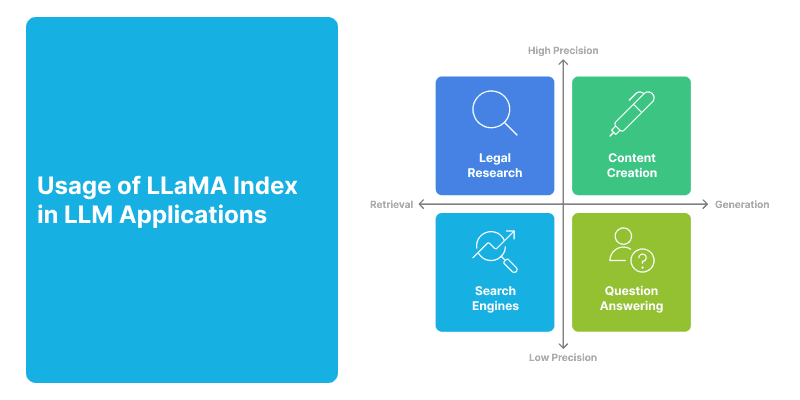
The LLaMA Index plays a critical role in several applications that rely on large language models. Here are a few key use cases where the index is particularly important:
Search Engines and Information Retrieval:
- When users search for specific information on a platform like a website or a digital library, LLMs with an indexing system like LLaMA Index can quickly retrieve and display the most relevant results. This improves user experience and reduces wait times.
Question-Answering Systems:
- In customer service chatbots or virtual assistants, the LLaMA Index helps the model find the correct information to answer user queries. This makes the system more efficient at responding to customer needs, providing accurate information more quickly.
Text Summarization:
- Summarizing long documents or research papers requires the model to first understand the key points. The LLaMA Index allows the model to prioritize relevant sections, making the summarization process faster and more focused.
Legal and Medical Research:
- In fields like law or healthcare, where precision is critical, LLaMA Index allows LLMs to quickly search through vast amounts of case studies, legal documents, or medical literature to find the exact information needed for a task.
Content Creation:
- Writers and content creators use LLMs for generating blog posts, social media content, or product descriptions. LLaMA Index helps these models pull in the most relevant information, ensuring that the content generated is accurate and in line with the given context.
Advantages of Using LLaMA Index
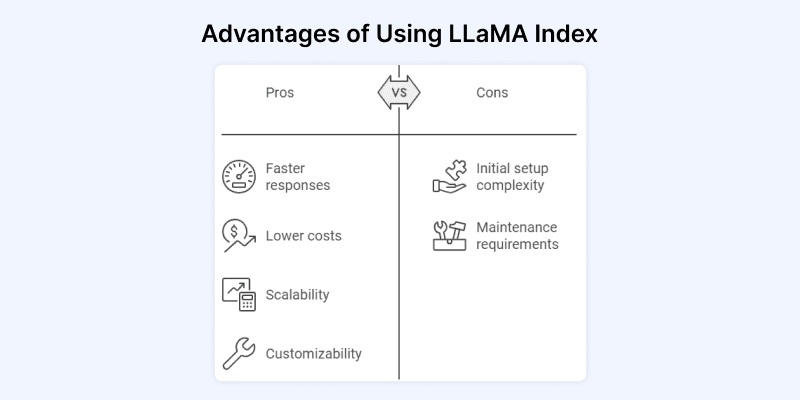
The LLaMA Index is vital for optimizing large language models, and its benefits can be seen in several areas:
Faster Responses: By indexing the data, the model can produce answers much more quickly since it doesn’t need to search through its entire dataset every time a query is made.
Reduced Computational Costs: With an organized indexing system, the model uses fewer resources to retrieve information, which lowers the overall computational cost. This is especially helpful for companies or researchers who have limited access to powerful hardware.
Scalability: As more data is added to the model, indexing ensures that the system remains scalable, meaning it can handle larger datasets without slowing down.
Customizability: The LLaMA Index can be fine-tuned for specific use cases. For example, a legal firm might create an index that’s specific to legal texts, allowing the model to excel at retrieving and analyzing legal documents.
Potential Challenges and Limitations of LLaMA Index
While the LLaMA Index plays a critical role in making large language models (LLMs) more efficient, it also faces several challenges and limitations. Here are some of the key issues that might arise:
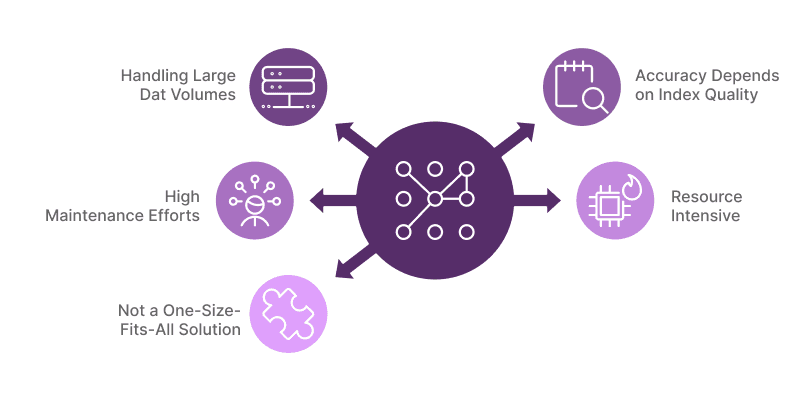
1. Handling Large Data Volumes
As datasets grow, creating and maintaining an efficient index becomes more complex and time-consuming. It requires powerful computing resources to keep the index up-to-date with new data, which can be a challenge for smaller organizations or individual users without access to advanced hardware.
2. Accuracy Depends on Index Quality
The accuracy of the model’s responses depends on the quality of the index. If the index isn’t created or maintained properly, the model might retrieve outdated or irrelevant information. This could lead to inaccurate or unhelpful responses.
3. High Maintenance Efforts
Regular updates are needed to keep the index relevant. This maintenance requires continuous effort, especially when dealing with dynamic or changing data. If the data source frequently changes, maintaining an up-to-date index can be a labor-intensive process.
4. Resource Intensive
Creating and updating the index requires significant computational power, especially for large-scale models. This can lead to higher operational costs, as powerful servers or cloud computing resources are needed to ensure smooth operation.
5. Not a One-Size-Fits-All Solution
The LLaMA Index needs to be tailored for different tasks. An index created for legal research might not work well for medical research, meaning customization is necessary. This tailoring adds another layer of complexity when applying the index to various industries.
Conclusion
The LLaMA Index is a crucial element in making large language models more efficient and user-friendly. By helping models like Meta’s LLaMA (and others) access information quickly and accurately, it opens up new possibilities for how AI can be used in fields like customer service, research, and content creation.
As large language models continue to grow in both size and importance, tools like the LLaMA Index will play an essential role in ensuring they remain efficient, scalable, and useful for a wide range of applications.
